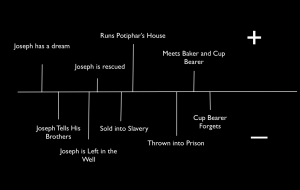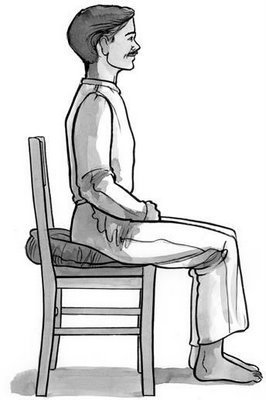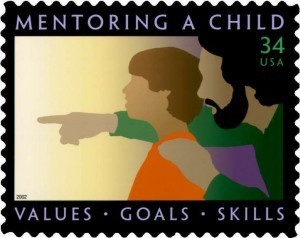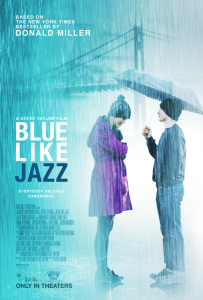Donald Miller's Blog, page 109
February 22, 2012
The Theology of Falling
 Today's guest post is from Sarah Raymond Cunningham, the author of multiple books. Sarah quit her job so she could write what she's passionate about and keep building a community called STORY. She also contributes to projects she believes in at People of the Second Chance. You can follow her newest endeavors, like onethousandpremieres.com, at her blog, www.sarahcunningham.org.
Today's guest post is from Sarah Raymond Cunningham, the author of multiple books. Sarah quit her job so she could write what she's passionate about and keep building a community called STORY. She also contributes to projects she believes in at People of the Second Chance. You can follow her newest endeavors, like onethousandpremieres.com, at her blog, www.sarahcunningham.org.
My son, the two-year old Emperor who claims to be Supreme Ruler of our household, has taken up sprinting parking blocks.
I could stop him by mumbling something about the dangers of concrete. But who knows? Maybe this quirky sport is going to take off like planking? Who am I to squelch such genius?
Here's how it works. The Emperor teeters on one edge of the bright yellow concrete beam. He does not even stretch out his arms for balance. With hands slicked down to his side, he is inarguably better positioned for being shot out of a cannon than walking a narrow beam.
The Emperor then charges ahead as if he believes he can run across the whole beam at full-throttle. Then he tumbles off, awkwardly smacking into the ground with so little awareness that he doesn't even raise his hands to break his fall.
This is where I make jokes about how he takes after his father. And think about whether I should make him be the weird kid at the park whose Mom forces him to wear a safety helmet.
For the Emperor's second attempt, he does not even consider reducing his speed. He manages an only slightly more gracious half-roll as he collides with the ground. Two strides. Grass stain. Then four. Skinned knees. And so it goes.
To spare you a recount of attempts five through fifty, here's the cliff notes: As a young toddler, parking block sprinting is a full contact sport rarely marked with success. What progress there is looks less like achieving balance and more like figuring out better ways of falling.
So much so that after a while, I literally begin to applaud the particularly good falls. I indulge in parental pride over what a good little tuck-and-roller he becomes.
I know it's a little cliché to draw meaning from the antics of your two year old, but I can't help but be a little jealous that my son is so undeterred by falling.
He doesn't stop to look around and see who is watching.
He doesn't analyze how whether people will judge him if he falls too many times.
Falling, to him, is nothing more than the moment that lies between his attempts at greatness.
And this makes me think that my son instinctively knows something that most of us spend a good chunk of adulthood trying to re-learn.
I'm hinting at a Theology of Falling Well, of course.
If I were writing my fictional doctoral dissertation on the subject, somewhere in Volume 1, I would include this idea: If you can't remember the last time you fell, that may mean you're not taking on any new challenges. And in that case, after a while, perfection becomes a fraudulent trophy, don't you think?
Another piece of advice that has occurred to me while lying on the ground goes like this:
It's okay.
We should run hard when we can, for as long as we can.
But when we can't run, we should walk.
If there comes a time when we can't walk, go ahead. Fall.
In general, when possible, it's better to fall forward than backward.
When we get up enough energy, we might only be able to manage a crawl. And if we're too exhausted to move, then all we might be able to manage is to lay on the ground and reach in the right direction.
But as soon as we can, it makes sense to get up. Many people finally succeed after getting up one more time than they fall.
We tend to platform faithfulness that comes in the form of heroic Biblical figures slaying lions, falling giants and becoming Pharaoh's right hand man. But in the Old Testament world and in ours, I'm pretty sure the greatest act of faithfulness is getting back up and putting one foot in front of the other again.
What if Daniel would've let captivity break him?
What if David would've wallowed in his dad's failure to recognize his potential?
What if Joseph would've stopped at being sold into slavery?
I submit to you that there would be no moment of triumph had it not been for the moment that they got back up.
The Theology of Falling is a post from: Donald Miller's Blog
February 20, 2012
A Conversation with me and Steve Taylor about Blue Like Jazz
After we flew to Florida to screen Blue Like Jazz for the staff at Relevant Magazine, they put together a microsite promoting the film. The staff was pretty afraid to see it because they loved the book and they thought we not have made a good enough movie. But they ended up loving the film and are promoting it like crazy. We are so grateful. Anyway, every once in a while I'll feature one of these little interview clips they created. But if you want to see them all, visit here.
Here's the clip:
A Conversation with me and Steve Taylor about Blue Like Jazz is a post from: Donald Miller's Blog
February 15, 2012
South by Southwest to Host World Premiere of Blue Like Jazz

We are pleased to announce Blue Like Jazz the Movie has been accepted as an official selection at the South by Southwest Film Festival.
South by Southwest is the 4th largest film festival in the world and second only to Sundance here in the states. The South by Southwest conferences, music, technology and independent film festivals are considered one of the most influential happenings on America's cultural calendar.
South by Southwest will host the World Premier of Blue Like Jazz on March, 10th. ALL HOTELS IN AUSTIN ARE BOOKED SOLID, so if you are traveling to the Austin area, feel free to use the comments feature on this blog to find somebody in Austin who can loan you their floor.
To see the film in Austin, you will need a film badge. Those are spendy, but we are checking to see if it's possible to buy a ticket to each film separately.
If you live in the Austin area and are adventurous enough to offer a spare bed, couch, or even a floor, let folks know in the comments section.
Q: When will the film be released?
A: April 13th nationwide.
Q: Will the World Premiere in Austin trump the premieres for Kickstarter backers?
A: Heck no. We are planning a huge premiere at the Bagdad Theater in Portland on April 10th and if you qualify as a backer, we've got a seat for you. Steve, myself, Marshal Allman and Claire Holt will all be on hand. Plus the real Penny (we hope) and our Director of Photography and cowriter Ben Pearson.
Q: Will there be any chances to see the film before it comes out?
A: Yes. Starting March 1, Steve and I (and sometimes Marshal) will be on a bus hitting 35 different cities. In each city, we will be screening the film for Kickstarter backers. I will post the tour schedule here on the blog in the next couple weeks. If you live anywhere near a city with more than a million people living in it, we will likely be coming to your town.
Q: Why would SXSW accept a Christian film?
A: It's a film about a Christian more than a Christian film. It's the first film of this type to ever be accepted by a major festival and we think they accepted it because it's really good. Or so we hope.
Q: Is SXSW the only festival that accepted Blue?
A: This is the only festival we submitted the movie to. Because we just locked the film recently, and are taking it to the box office in April, this festival is the only one we were eligible for. That said, we all feel we could have been accepted at a few of the others. Who knows.
For news about the film the second it happens, sign up for our e-mail news blasts. We won't hit you too often, we promise.
South by Southwest to Host World Premiere of Blue Like Jazz is a post from: Donald Miller's Blog
February 13, 2012
You and Your Friends can Start a Mentoring Program
You and your friends can start a mentoring program. You don't need a lot of money, a building, an organization or a license. Mentoring is about friendships. If you've got a group of healthy guys you call friends, consider picking up the toolkit we provide and expanding your little group into a full-on mentoring program.
Loved seeing this interview with Kevin Hommel of Memphis who is doing amazing work there mentoring fatherless boys. Kevin has teamed up with The Mentoring Project and the Memphis Grizzlies to create a community of mentors. If you'd like to crate a program in your town, we can certainly help. Visit www.thementoringproject.org and order our tool kit. You and your group of friends will be changing lives within weeks.
You and Your Friends can Start a Mentoring Program is a post from: Donald Miller's Blog
February 9, 2012
The Power of Knowing Your Story
Ever walked into a movie halfway through? You were likely scrambling your brain trying to figure out what's happening on screen. If you were lucky you had a friend whisper in your ear to catch you up.
Often, when people attend the Storyline Conference, this is their experience. Only they've not walked into a movie, they've walked into their life. It's just that they hadn't been paying attention.
One of the ten exercises we do at Storyline is to fill out our timeline. In this exercise, we list the positive and negative turns we've experienced and then place them on a grid that allows us to see the trajectory of our lives.
There are many benefits to this exercise, but the biggest ones are:
1. We realize that we've been blessed more than we'd previously thought.
2. We get a general sense that somebody is watching over us.
3. We realize that the negative turns in our lives eventually turn out okay.
4. We also realize that the negative turns have usually produced some kind of blessing, either by shaping our character or by preparing us for an important responsibility.
5. We begin to understand that our experiences have prepared us for something important.

You don't have to attend a Storyline Conference to fill out your timeline. You can do it at home. I recommend creating the timeline with a group of friends or with your spouse. Here's how it works.
• List the positive and negative turns you've experienced in your life. If you are 30, you've had between twelve and fifteen. A positive or negative turn is a story term and all good stories involve BOTH positive and negative turns. You can't tell a good story without conflict, so the negative turns are just as, if not more important.
• Rate each positive turn on a scale of +1-10 and each negative turn on a scale of -1-10.
• Draw a horizontal line across the middle of a sheet of paper. At Storyline, we provide an elongated, folded piece of card stock. You may need a long sheet for this. (Imagine an elongated goalpost like in football. You want to draw an "H" with the center piece stretched across the page.
• In chronological order, place each life turn on the page. Draw a line up and list positive turns (the line should be as tall or short as the number value you gave it. Do the same for the negative turns.
When you're done (this is a reflective exercise and it may take you a couple days) go through each negative turn and ask yourself why you are grateful that this hardship happened to you. Ask yourself what is the redemptive value of this negative turn.
I've posted a picture here of Joseph's timeline. Joseph was the shepherd in Genesis who became the second most powerful man in the world. As you can see, his life was filled with trouble. But if he hadn't been sold into slavery, run Potiphar's house, been imprisoned and run the prison, he would never have been qualified or able to become great.
Life looks differently when you understand it as a story.
Also, share your timeline with a spouse or close friend. At Storyline, we are always amazed at how couples who've been married for years understand each other in a much more comprehensive way.
The Power of Knowing Your Story is a post from: Donald Miller's Blog
February 8, 2012
From a Rainy Day to a Starry Night
 Today's guest contributor is Anne Jackson. Anne writes. She's written some books and although most of the time she doesn't like the internet much, she occasionally writes at AnneJacksonWrites.com. She also rode her bicycle across the country much like Don, although much slower.
Today's guest contributor is Anne Jackson. Anne writes. She's written some books and although most of the time she doesn't like the internet much, she occasionally writes at AnneJacksonWrites.com. She also rode her bicycle across the country much like Don, although much slower.
I pulled on the chain for my hotel window's curtain, a small part of me hoping to see sunlight filling my room as the shade lifted. Nothing is more perfect than a sunny, autumn day in New York City.
With each tug, my room didn't brighten. The puddles that were forming in the parking lot three stories down confirmed the weatherman on Channel 2 was accurate in the previous night's forecast.
Rain.
Rain is not the end of the world. In fact, I kind of enjoy it. The water gives life to the plants, the animals, the forgotten. It washes away soot and smog and carries it to the sewer grates. It promises something new.
As often as I travel, of course I come prepared for rain; the word prepared meaning, "I know there is a small shop in the train station that sells umbrellas for $3, so if it rains, I'll be okay." Off to the shop I went. $3 umbrella purchased. Train boarded.
Forty five minutes later as I walk up the stairs from Penn Station to the streets of Manhattan, I open my new-found friend, the umbrella. What occurred in front of me was almost magical, the unnatural becoming natural. As my umbrella popped open to shield me from the pelting rain, so did umbrellas from the hundreds of people around me as they marched out of the undergrounds and into the street.
$3 umbrellas are black, but true New Yorkers carry umbrellas with style. Reds, yellows, green with white stripes, polka dots, pinks…one by one the umbrellas arched up and bloomed like flowers after a spring rain, each one taking a different shape, brightness, and place on the vertical landscape.
Maybe walking through this plastic garden in the rain wouldn't be so bad after all.
One mile later, I found myself in front of a hotel where a friend of mine had just given a presentation. This friend is not only a friend, but a confidant, a mentor, and a soothsayer. I had no idea what plans he had for us, but we slid into a cab with our wet umbrellas and backpacks and he asked the cab driver to take us to the Museum of Modern Art.
He asked me if that was okay.
That is like asking me if eating a chocolate lava cake for dinner is okay.
(The correct answer is yes, just in case you were unaware of my deep appreciation for chocolate, and art for that matter).
We arrived, and my friend flashed his membership cards in the right places as we climbed the stairs. This was my first trip to the MOMA, and I had no idea what was even being exhibited. He grew up in a family surrounded by fine art, so his knowledge of each painter, each context, and how they came into being (or passing for that matter) is rich and vast. We wandered through several of the rooms as he crafted a story weaving through Seurat to van Gogh, from Matisse to Mondrian and Magritte.
What was the story of each painter? How was their art received in their time, and now?
But beneath the art history lesson, he had a subtle and necessary agenda.
How are these paintings and these similar to my own journey?
Occasionally, we'd sit in a room, and whatever collection we had just passed he transformed into something tangible and relevant to the very steps I'm taking right now. What does van Gogh have to do with my writer's block? A lot, actually. And what about rejection and being confident with my work (and myself) can I learn from a formerly mocked work of Matisse? More than I can share here.
I'm no stranger to art — I studied it quite thoroughly growing up. As well known as Starry Night is, it has always been one of my favorites. Even my "I-don't-want-to-be-trendy" point of view can't escape how it moves my soul. It touched me deeply in 2005 when I was in a discouraging place. And to see it, finally, up close and personal, was a breathtaking moment. Tears formed in my eyes as we stood before a handful of more recognizable pieces of his work.
These paintings are part of Vincent van Gogh.
He painted them.
He touched them.
He crafted them.
He created them.
Something in his heart made him paint them.
And even as my friend drew similarities between life and van Gogh, I couldn't help but realize the profound effect seeing the actual paintings was having on me. As true as the words my friend was speaking were, the fact he was saying them as I stared at these paintings caused me to wonder…
"What – and maybe more importantly how – am I painting?"
I write words and they are sometimes put in books. Sometimes they are digitally transferred onto my computer screen, and your computer screen. Are these words as purely conceived in the same way each layer of Starry Night was painted?
Will someone read them one day and think of the soul of the girl behind them and be amazed? In tears?
Please let me clarify: It's not because I believe anyone should be amazed in me, as a person. I am just flesh and blood and spirit and mistakes and hope and a bad driver. And I'm fairly sure van Gogh didn't have any "what will people think?" thoughts running through his mind as he painted, either.
However, I do believe there is a purity and honesty in each of us that can be released when we set aside our expectations, our fears, and our desire to please others and simply paint whatever that unspeakable and great thing that's inside of us. The world will take notice. Not of us, but of the great Starry Night in us that will transcend them and inspire them into believing the truth about the goodness that is inside of them as well.
"I often think that the night is more alive and more richly colored than the day." – Vincent van Gogh
With this story, I only ask you to remember this: even in the darkest nights and the rainiest of days, moments of light and color mysteriously, majestically, and sometimes whimsically (like a rainbow of flowers disguised as umbrellas) shine through. Paint that truth.
From a Rainy Day to a Starry Night is a post from: Donald Miller's Blog
February 6, 2012
An Empire Built On Love
 I read a quotation recently in which the French emperor Napoleon Bonaparte, musing on the negotiation of clout, gave an appropriate summation of the power of Christ's love and kindness, saying, "I know men; and I tell you that Jesus Christ is no mere man. Between Him and every other person in the world there is no possible term of comparison. Alexander, Caesar, Charlemagne, and I have founded empires. But on what did we rest the creations of our genius? Upon force! Jesus Christ founded His empire upon love; and at this hour millions of men would die for Him."
I read a quotation recently in which the French emperor Napoleon Bonaparte, musing on the negotiation of clout, gave an appropriate summation of the power of Christ's love and kindness, saying, "I know men; and I tell you that Jesus Christ is no mere man. Between Him and every other person in the world there is no possible term of comparison. Alexander, Caesar, Charlemagne, and I have founded empires. But on what did we rest the creations of our genius? Upon force! Jesus Christ founded His empire upon love; and at this hour millions of men would die for Him."
I confess, I have often wondered how a soft Jesus would instill such devotion in the hearts of men. I suppose the answer rests in this mingling of challenge and kindness. But the kindness part is not so palatable for me, the word kindness rings as a synonym to, well, weakness, wimpiness.
I came across a book a few years ago, however, that helped me understand the power of kindness in leadership. The book was about a man named John Gagliardi and his career as head football coach at St. John's University. The unorthodox method in which Coach Gagliardi leads his players is intriguing, if not completely odd. An anomaly to say the least, Coach Gagliardi does not ask his players to lift weights during the off-season, holds no spring practice, and rarely allows players to hit each other during drills. Instead, Gagliardi employs an exercise called the "Nice Day Drill" in which players lie flat on their backs, stretch left and say to the player beside them, Nice day, then stretch right to say the same to the player on the other side. During stretching exercises, captains greet their teams with smiles and ask them to comment on the beauty of the day. Players then look around the field, up to the sky, out to the trees, and comment on the nice colors and soft breezes.
I couldn't help but laugh as I read, quite honestly, until I got to the part of the book that mentions St. John's win record within their very competitive division. Coach Gagliardi is the winningest football coach in the history of college football or, for that matter, any football. He has more wins than any five NFL coaches combined. The results of Gagliardi's unique philosophy are phenomenal. And what of the performance on the field? The players systematically score above each and every rival, recently by more than 70 points.
John Gagliardi points out that St. John's is a Catholic school and the monks who run the university, when they hired him, were looking for two things in their football program: (1) a program that reflected the leadership style of Jesus, and (2) wins. Lots and lots of wins.
Coach Gagliardi says players are asked to treat their teammates in the way they would like to be treated, with kindness, graciousness, and altruism. The players work as hard as they want to work, and when they come to practice they do exactly as the coach asks them to do, not because their positions will be threatened if they don't (St. John's offers no football scholarships), but because they care about one another, work as a team, and love their coach because they sense his love for them.
And so when I consider the way I am treated by Christ, the degree of kindness with which He guides me, I know that as Napoleon said, I would die for Him. And I would not die for Him because He threatens me; I would die for Him because He loves me, and because I am part of a community of people who are committed to one another, to the world, and to the mission of Jesus.
This passage was an excerpt from Searching for God Knows What.
An Empire Built On Love is a post from: Donald Miller's Blog
February 1, 2012
The Three Dominant Biblical Metaphors Describing Our Relationship with God
 Biblically, you are hard-pressed to find theological ideas divorced from their relational context. There are, essentially, three dominant metaphors describing our relationship with God: sheep to a shepherd, child to a father, and bride to a bridegroom. The idea of Christ's disciples being His mother and father and brothers and sisters is also presented. In fact, few places in Scripture speak to the Christian conversion experience through any method other than relational metaphor.
Biblically, you are hard-pressed to find theological ideas divorced from their relational context. There are, essentially, three dominant metaphors describing our relationship with God: sheep to a shepherd, child to a father, and bride to a bridegroom. The idea of Christ's disciples being His mother and father and brothers and sisters is also presented. In fact, few places in Scripture speak to the Christian conversion experience through any method other than relational metaphor.
Contrasting this idea, I recently heard a man, while explaining how a person could convert to Christianity, say the experience was not unlike deciding to sit in a chair. He said that while a person can have faith that a chair will hold him, it is not until he sits in the chair that he has acted on his faith.
I wondered as I heard this if the chair was a kind of a symbol for Jesus, and how irritated Jesus might be if a lot of people kept trying to sit on Him.
And then I wondered at how Jesus could say He was a Shepherd and we were sheep, and that the Father in heaven was our Father and we were His children, and that He Himself was a Bridegroom and we were His bride, and that He was a King and we were His subjects, and yet we somehow missed His meaning and thought becoming a Christian was like sitting in a chair.
This passage was an excerpt from Searching for God Knows What.
The Three Dominant Biblical Metaphors Describing Our Relationship with God is a post from: Donald Miller's Blog
January 31, 2012
Why Scripture Includes So Much Poetry
 Perhaps the reason Scripture includes so much poetry in and outside the narrative, so many parables and stories, so many visions and emotional letters, is because it is attempting to describe a relational break man tragically experienced with God and a disturbed relational history man has had since then and, furthermore, a relational dynamic man must embrace in order to have relational intimacy with God once again, thus healing himself of all the crap he gets into while looking for a relationship that makes him feel whole. Maybe the gospel of Jesus, in other words, is all about our relationship with Jesus rather than about ideas. And perhaps our lists and formulas and bullet points are nice in the sense that they help us memorize different truths, but harmful in the sense that they blind us to the necessary relationship that must begin between ourselves and God for us to become His followers. And worse, perhaps our formulas and bullet points and steps steal the sincerity with which we might engage God.
Perhaps the reason Scripture includes so much poetry in and outside the narrative, so many parables and stories, so many visions and emotional letters, is because it is attempting to describe a relational break man tragically experienced with God and a disturbed relational history man has had since then and, furthermore, a relational dynamic man must embrace in order to have relational intimacy with God once again, thus healing himself of all the crap he gets into while looking for a relationship that makes him feel whole. Maybe the gospel of Jesus, in other words, is all about our relationship with Jesus rather than about ideas. And perhaps our lists and formulas and bullet points are nice in the sense that they help us memorize different truths, but harmful in the sense that they blind us to the necessary relationship that must begin between ourselves and God for us to become His followers. And worse, perhaps our formulas and bullet points and steps steal the sincerity with which we might engage God.
Becoming a Christian might look more like falling in love than baking cookies. Now don't get me wrong. I am not saying that in order for a person to know Jesus they must get a kind of crush on Him. But what I am suggesting is that, not unlike any other relationship, a person might need to understand that Jesus is alive, that He exists, that He is God, that He is in authority, that we need to submit to Him, that He has the power to save, and so on and so on, all of which are ideas, but ideas entangled in a kind of relational dynamic. This seems more logical to me because if God made us, wants to know us, then this would require a more mysterious interaction than what would be required by following a kind of recipe.
I realize it all sounds terribly sentimental, but imagine the other ideas popular today that we sometimes hold up as credible. We believe a person will gain access to heaven because he is knowledgeable about theology, because he can win at a game of religious trivia. And we may believe a person will find heaven because she is very spiritual and lights incense and candles and takes bubble baths and reads books that speak of centering her inner self; and some of us believe a person is a Christian because he believes five ideas that Jesus communicated here and there in Scripture, though never completely at one time and in one place; and some people believe they are Christians because they do good things and associate themselves with some kind of Christian morality; and some people believe they are Christians because they are Americans. If any of these models are true, people who read the Bible before we systematically broke it down, and, for that matter, people who believed in Jesus before the printing press or before the birth of Western civilization, are at an extreme disadvantage. It makes you wonder if we have fashioned a gospel around our culture and technology and social economy rather than around the person of Christ.
This passage was an excerpt from Searching for God Knows What.
Why Scripture Includes So Much Poetry is a post from: Donald Miller's Blog
January 30, 2012
Mentoring: The Ancient Solution for Future Generations
 Today's guest post is courtesy of Josh Shipp. Josh is a teen behavior expert who has lectured at Harvard, Stanford, and who's work has influenced more than two million teens and parents. He is the author of The Teen's Guide to World Domination and host of Jump Shipp on Halogen. You can find more about him at his website, JoshShipp.com.
Today's guest post is courtesy of Josh Shipp. Josh is a teen behavior expert who has lectured at Harvard, Stanford, and who's work has influenced more than two million teens and parents. He is the author of The Teen's Guide to World Domination and host of Jump Shipp on Halogen. You can find more about him at his website, JoshShipp.com.***
The biggest threat to young people today is YOU. Rather, the absence of YOU. It's not drugs or alcohol. It's the lack of positive adult mentors in their life, and I see it with every at-risk teen I work with.
A teen with a mentor is 46% less likely than their peers to start using illegal drugs. I wholeheartedly believe every student is ONE mentor away from being a success story. This flip side, of course, is every mentor is ONE student away from being a success story. Mentors and students need each other. The student needs an example to follow. The mentor needs the motivation to be a good example. God designed it this way. Leadership is best applied in relationship.
People have always sought to learn from those who were more experienced or more knowledgeable. This relationship has taken on various forms throughout history, but relational leadership is the oldest form of education. Before mentorship, there was apprenticeship, a system of training a new generation of practitioners in a skill or trade. A young apprentice would build his career based on his master's methods of doing business.
Before apprenticeship there was discipleship, like Socrates who taught Plato who taught Aristotle. This was a more intense process of living life with a master teacher. The master would show the student how to talk, walk, eat, and especially how to think. Before the Middle Ages, discipleship was considered the preferred track to rapid personal/spiritual growth. Being chosen to follow a master was an immense honor and would be equivalent to today's full-ride scholarship to a university. If you were invited to be discipled by a master teacher, your entire family would adjust their lives around this once-in-a-lifetime opportunity.
People develop best with formal relational leadership. Consider this: personal life coaching is a $1.5 billion dollar a year industry, and it's growing rapidly. Why? Because there is a lack of mentorship in our country, and people are so desperate for it they are willing to pay. I've hired life coaches myself, and can be effective for highly-targeted breakthroughs. The problem is, hired guns aren't truly invested in my life. What life coaching is to mentoring, prostitution is to real love: a degrading substitute for the real thing.
So where have all the mentors gone? At the peak of the industrial revolution at the turn of the twentieth century, the U.S. Government made secondary education mandatory partly as a recourse to dangerous labor environments forced upon young workers. While mandatory formal schooling was instituted out of good intentions, it often fails to address character development. By segregating our youth from the adult population, we force fourteen year-olds to learn about life from sixteen year-olds. The secondary education path is fine for kids with strong family bonds, but those without strong leadership figures are often left behind. The result has been a perpetual "fatherless generation complex" growing more at-risk each year. Youth cannot reach their potential through the influence of peers. They best mature through the influence of older, wiser, and more experienced mentors. If generational segregation was the start of the moral downfall of youth culture, than re-connection through formal mentorship is the logical solution to empower youth against the curse of low expectations.
For the sake of our nation's future, we have a collective responsibility to mentor young people. I have made mentoring a strategic tool I use when working with at-risk youth. I have found that helping a family create a "village of supporters" from members of their community is the surest way to see rapid transformation in a child. Here are the four structural components of a vibrant mentoring relationship you can use with a young person in your life:
1. Mentoring works best with formal structure. Truthfully, we adults can be flaky, forgetful and busy, but students can be especially undependable. That is why formal structure is a non-negotiable for me. I like to design a formal mentoring structure that promotes informal relationship. For example, every mentor and student I train writes out a simple one-page contract that lays out the expectations of the mentoring relationship. including meeting times, expectations, and specific goals that the student wants to attain. This extra step ensures a healthy start by providing specific direction and subconsciously raises the value of the relationship.
2. Mentoring works best when done weekly. The old adage that says, "you get out what you put in" rings true with mentoring. If you plan on mentoring a student once a month, you will get a quarter of the impact compared to a weekly meeting. Students need weekly interaction in order to keep you updated with their rapid-changing life. If you can't do a face-to-face each week, make yourself available via phone or email for real-time conversation. The more at-risk the student is, the more interaction they need to stay accountable to making healthy choices. Daily accessibility helps you stay connected with the student during the fragile "in-between gaps" of the week.
3. Mentoring works best through activities. Students reject clinical environments. They are not interested in therapy sessions; they are interested in friendship. It's in the best interest of the mentor to discover what the student loves to do and create activities with that in mind. Mentoring is a selfless task, much like parenting. You have to be willing to do activities you might not be fond of. Whatever the activity, be sure to choose ones that allow you to engage in conversation. Watching a movie or playing video games are not ideal. Playing ball, fishing, helping with homework, etc., are activities that provide moments of significant conversation. Be purposeful with every encounter by having at least one thought-evoking and one thought-provoking question that will encourage thinking. An evoking question is designed to draw something out, like, "What problem is in your life right now that you could use help solving?" A provoking question is designed to give a new idea, like, "Would your home-life be more peaceful if you spoke to your mother respectfully?". Write these questions down in advance and show up prepared to mentor.
4. Mentoring works best with a goal. It is important that we teach young people how to set goals, work hard, and accomplish something. This skill alone could save their life in the near future. I always encourage the mentor to ask the student, "If I could help you accomplish something in the next three months, what would it be?" No matter how trivial the goal might seem, you have a huge opportunity to take them through the logical process of goal setting and planning. This positions you as their supporter and gives you both a project to work on together. The goal may be to get a bully to stop teasing, asking a girl to the school dance, or passing a math exam. Whatever seems important to them is what you should work on. Don't try and give them a goal that they are not passionate about. The ultimate reason for teaching them to set goals is to help them transfer this skill into adulthood, where the stakes are higher. This is arguably the most important skill set they need to navigate the fragile years of adolescence. Help them figure out where they want to go and equip them with the skills to get there. This encourages leadership and cures chronic followship.
Towards the end of His life, Jesus commissioned His followers to "go and make disciples." The Creator of mankind understood that the best way to help others grow is through the exchange of truth and life. His formal process included an initial call to follow, a clarification of expectations, and a commitment to finish whatever project is started. I am convinced that we MUST respond to His commissioning and follow His example. When we do, we discover what He was trying to teach His followers: more time with less people equals greater impact. I pray that you, too, will answer His call to invest in the next generation. Our future depends on it.
Mentoring: The Ancient Solution for Future Generations is a post from: Donald Miller's Blog
Donald Miller's Blog
- Donald Miller's profile
- 2745 followers




